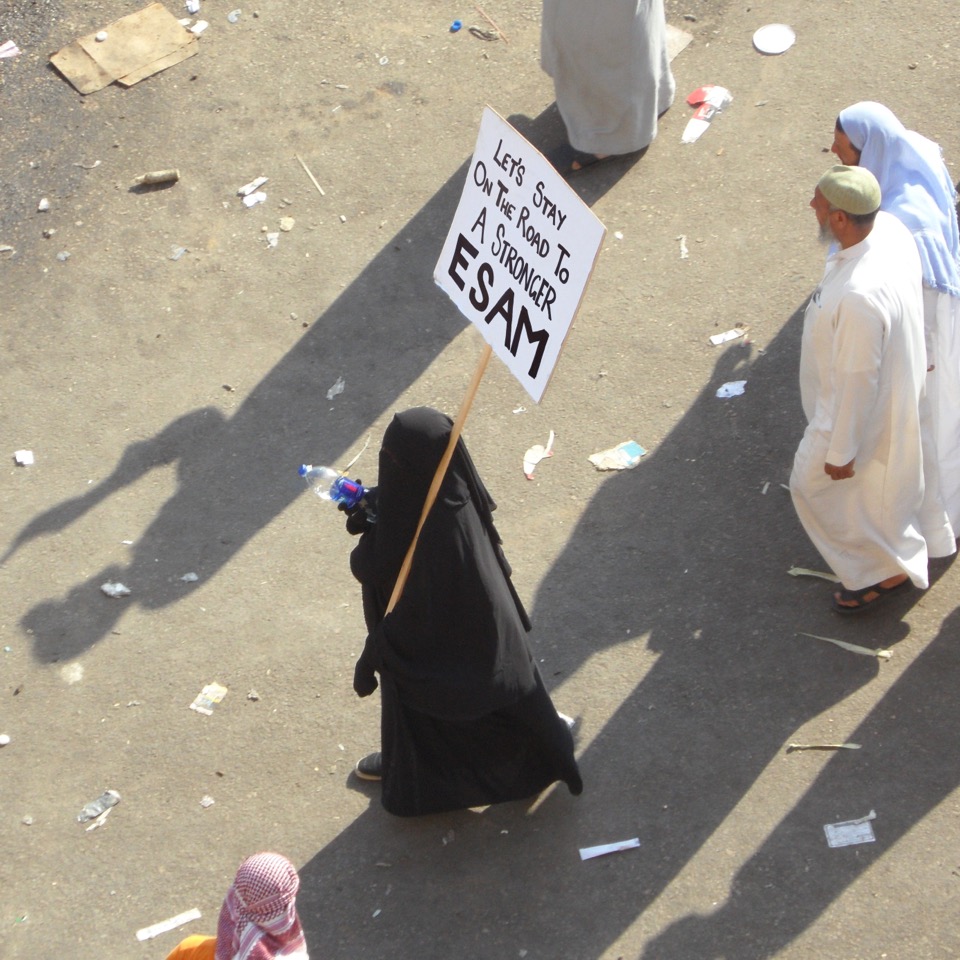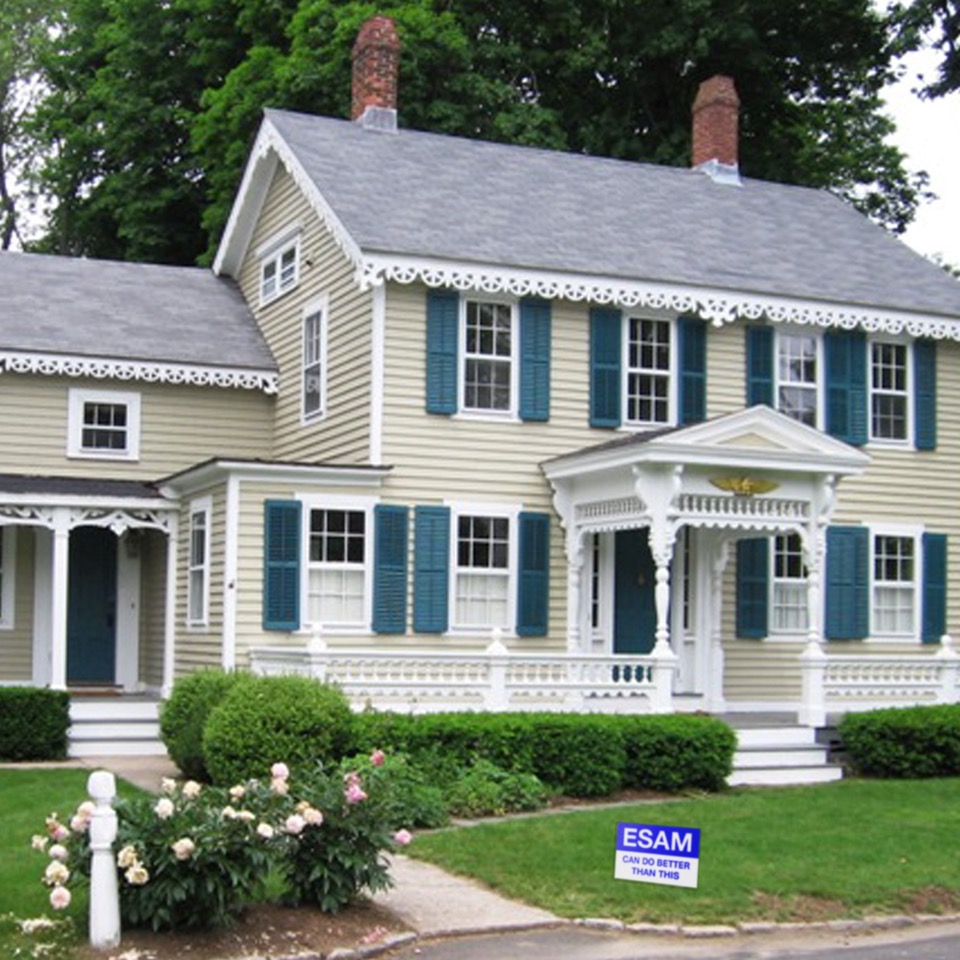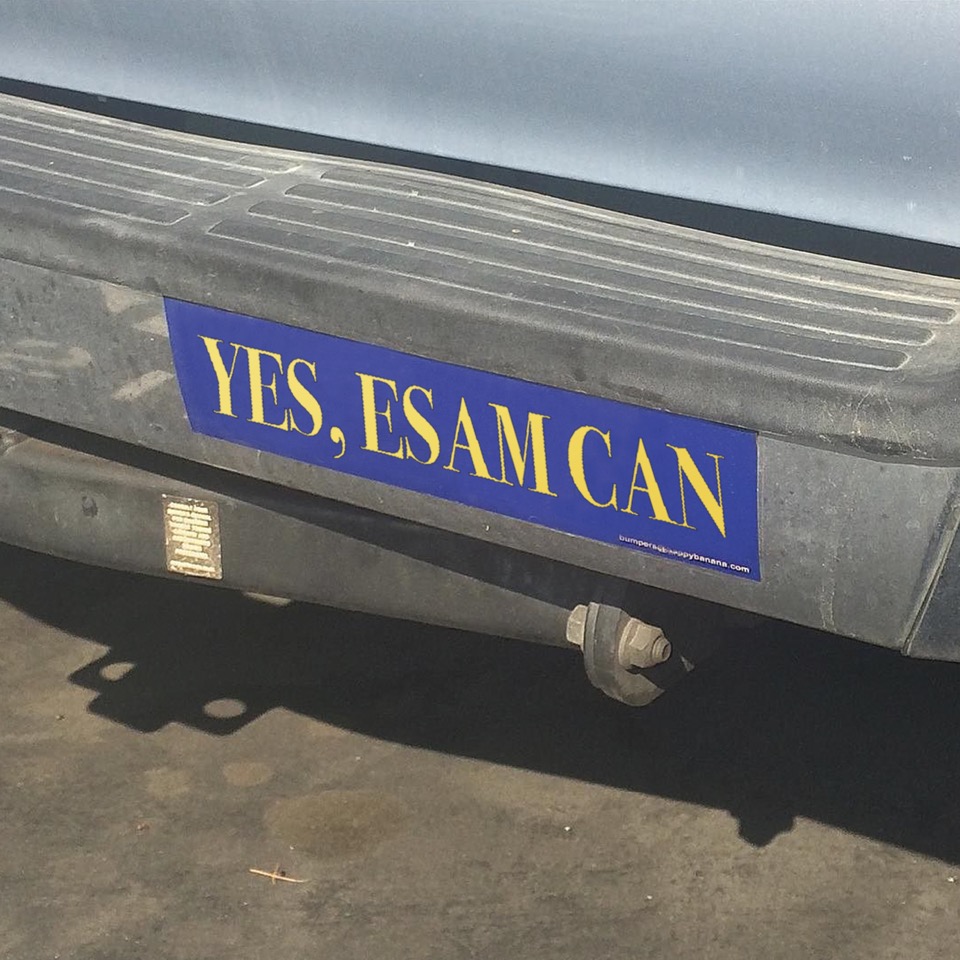
Esam, Tom, Let’s Stay On The Road To A Stronger Esam, 2016. Printed 100% Silk Georgette 50gsm with white hem, 94 x 94 cm, unique. Courtesy of Roman Road and the artist. © Tom Esam
Can you tell me a bit about Complex Problems, Simple Solutions?
The show is about the over-simplification of political arguments in the media. It is made up of 16 new works on silk. They’re all images of protest; each image shows someone holding up a famous slogan that has been rendered meaningless by the substitution of my surname (Esam) into it. I have chosen deliberately emotionally-charged images, some of which trigger feelings of solidarity, but any references to the original context of the material and the people in them — their time, their nationality, their cause — have been removed.
What is behind the decision to use your own name in your slogans?
I started putting myself in my work around two years ago. I was uncomfortable with how important the artist’s personality had become. I view it as a hangover from the time of myth-making artists, gallerists and historians. Many of the historic figures of the 20th and 21st century are memorialised and celebrated as extreme idiosyncratic personalities. The crazed, decadent, passionate maniac. The reclusive, awkward intellectual. The gentle, soft-spoken outsider figure. There are so many cliché personality traits that get talked up in order to market the work of an artist. It seems that to promote certain artists through their character they are reduced to caricatures. People are more complicated than that; personalities change all the time, most people differ vastly everyday. I began to respond to that through work that appropriated the mannerisms of advertising and made grandiose claims about myself and my artistic identity. I combined phrases like ‘open minds, free souls’, ‘I am the revolution, a powerful stride’, ‘power, beauty and soul’ with my image. I hoped that by repeatedly claiming I am so many different contrasting things it would reduce my actual personality within the work. It was also a way of representing what the designers of aspirational adverts want from you; they want you to see the consumer as the main character in their adverts.
I continued using Esam as a meaningless filler in these new works. It pulls them all together, unites them through the use of my name as author and producer, but reduces the name to just a word. It is not a word that people can attach meaning to easily, it functions as a useful stopgap. It also draws the parallel between branding in advertising and politics, and links the two series together. I am really obsessed with language and imagery that seems to say something important but under further scrutiny falls away into meaninglessness. Individually the messages in the new works on silk are deliberately meaningless but as a body of work they represent the negative aspects of how political messages are fed to the masses through the media and mainstream political organisations.

Esam, Tom, Esam Can Do Better Than This, 2016. Printed 100% Silk Georgette 50gsm with white hem, 94 x 94 cm, unique. Courtesy of Roman Road and the artist. © Tom Esam
The words of politicians are particularly mistrusted in the UK right now. Do you see this is as a global feeling, and why do you think this has happened?
I started on this project pre-Brexit which I really didn’t see coming. As a British person living in Germany it felt like a punch in the stomach. But a few weeks later, looking on the bright side, I realised I couldn’t pick a better place for this show than a post-Brexit London, a place still reeling from an emotion over best-interest victory.
With politics, I can only really speak of the UK and US, as they are the two systems I feel I have at least some understanding of. From looking at which news outlets are most popular, it doesn’t seem like people want complexity in their news. Political speeches are reduced to soundbites and slogans. As a result of this, a new generation of politicians have evolved who realise that if you just repeat the party position statement in the face of any question, the majority of press outlets will go with it.
This seems to be combined with an increase in people voting with their gut. I love democracy but the idea of the importance of voting has to be combined with some serious research into what, rather than who, you’re voting for. In a time where the global political landscape is shifting, it is more important than ever — in opposition to the recent words of Michael Gove — to turn to the facts of our situation, rather than a well-produced personality.
When do you think we lost the truly persuasive rhetoric of the Greeks and Romans?
That is really hard to say. I’m not sure political speakers have lost it; I just think it is no longer something at stake when addressing the public. Why opt for intelligent, reasoned argument when you can pretend you have the answers, playing to emotions, and resolve it later if it is in fact your intention to do so? We are lucky in this country to have recorded debate from the House of Commons, but the problem exists in how statements and debates are interpreted, edited and spun in toxic, agenda-driven media campaigns.
How do you explore the visual aspects of your work alongside your written statements? Do you create the statements first and build around them?
I’ve collected a huge number of public domain images of protest and political campaigning, alongside a collection of some of the most famous political slogans and taglines from the last 100 years. Some slogans just fit with certain images. The major thing I have worked hard to avoid is creating any logical political narratives, as in: which slogan, when and where. For example, Trump’s ‘Make America Great Again’ held up by an Isis fighter has a crude logic that I am trying to avoid. I’m not interested in making works that individually comment on specific political situations. For this show I decided to make a collection of works that were deliberately meaningless and incongruous. My aim is to remind the viewer of the thousands of images attached to certain causes that we digest everyday. I am encouraging a distrust of political emotion through a deeper, critical assessment of images and slogans, both historically and in our current moment.
‘Tom Esam: Complex Problems, Simple Solutions’ runs from 24 August until 23 September at Roman Road






